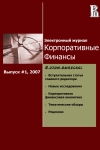Seasoned Equity Offerings Effects
Abstract
Authors: Elena Vladimirovna Chirkova - National Research University The Higher School of Economics
A R Toktonaliev
This article is an attempt to review the research results of the seasoned equity offerings (SEO) in the empirical literature. It addresses the widely known SEO phenomena observed in different countries such as announcement effect – negative price reaction to SEO announcement, underpricing of seasoned equity and long-run underperformance of issuing company.The article contains the data on negative price reaction to SEO announcement and also prescribes the hypotheses explaining this effect: the downward slopping demand curve hypothesis, capital structure hypothesis, transaction cost hypothesis and information hypothesis. The article provides the evidence of the impact of the following factors on announcement effect: the use of proceeds, information releases, equity issue volume, phases of the business cycle, cumulative abnormal stock performance and size of the issue. The article analyses the findings of the study of SEO discounting and the change in average SEO discounts over time as well as the impact of such as factors like exchange of issue, underwriter reputation contained in the academic literature. It also addresses the following hypotheses explaining SEO discount pattern: changing issuer composition hypothesis, leaving a good taste hypothesis, the short-selling hypothesis, increased investment banking power hypothesis. Authors also consider the worldwide phenomenon of long-run underperformance of issuing companies. The article also states various hypotheses that explain this pattern: windows of opportunities and manifestation of misspecified model.

